Sant'Angelo Art Story | Location | Opening Hours Tickets | Authorisations
Castel Sant'Angelo in Rome in Italy
The Mausoleum of Emperor Hadrian
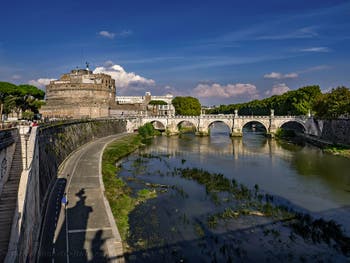
Castel Sant'Angelo along Tiber River The castle’s origin goes back to Emperor Hadrian, who built it as a mausoleum to his glory and that of his family.
The work lasted 18 years, from 123 to 139 AD.
It was therefore finished a year after the death of Hadrian.
This choice of Hadrian was also linked to the fact that the mausoleum of Augustus, where the previous emperors had been buried, was... full!
So much so that Hadrian’s predecessor, Emperor Trajan, had to be buried under his memorial column, the Trajan Column.
The need to build a new burial site was therefore imposed on Hadrian.
Castel Sant'Angelo: Impressive dimensions
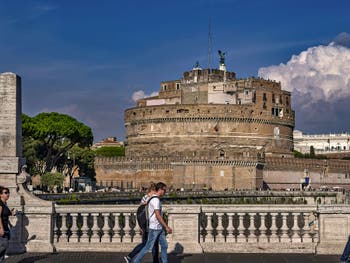
The Castel Sant'Angelo A good opportunity to glorify oneself posthumously and, as such, the imposing dimensions of Hadrian’s mausoleum speak for themselves.
The mausoleum was built on a square base with sides of 89 meters.
On this square base lies a cylindrical floor of 64 meters in diameter, surmounted by another cylinder that, placed on an altar, dominated a quadrigal led by Hadrian himself, represented as the Sun King and sitting 50 meters high in the sky of Rome!
According to Etruscan tradition, this upper cylinder was a burial mound covered with soil, and the statue of Hadrian was surrounded by cypresses and statues.
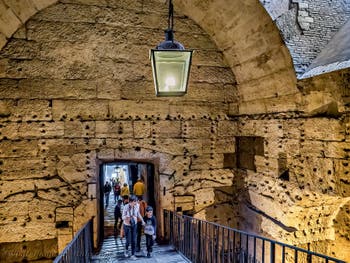
The Urns' Room in Castel Sant' Angelo The sepulchral chamber was in the centre of this upper cylinder.
It was in this room that the ashes of Hadrian, and those of the other emperors buried here following him, were placed in gold urns.
The burial chamber still exists; you can see it during your visit, but the ashes have disappeared.
After Hadrian, and until the 3rd century, the mausoleum was also the tomb of members of the Antonine and Severan families.
The last emperor to be buried here was Caracalla, assassinated in 217.
A terrace with a breathtaking view of Rome
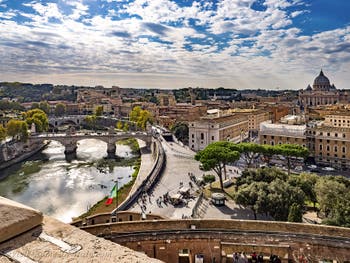
View from Castel Sant' Angelo While the castle’s interior, museum, frescoes and paintings alone are worth a visit to Castel Sant’Angelo, you should go up to its upper terrace, where the bronze angel stands.
From up there, the view over Rome is exceptional.
Right at your feet, the Sant’Angelo Bridge is the first gift you see.
From there, you can also see the Vatican and Michelangelo’s dome in St. Peter’s Basilica like nowhere else in Rome, as well as the Tiber and the cloud of domes of Roman churches that stand among the cypresses.
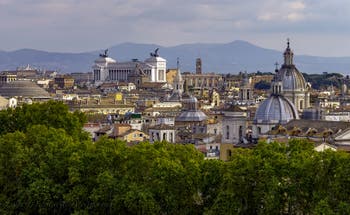
View from Castel Sant' Angelo Not to mention the Pantheon and the Colosseum, which are particularly recognizable on the other side of the Tiber.
And if you have time, since the museum closes quite late in the evening, go up to this terrace to watch the sunset over Rome.
A surprising sight when we see St. Peter’s Basilica blush before our eyes!
And if you have trouble recognizing this or that monument from the terrace, don’t worry. Large information boards are on each side with the names of all the monuments, palaces and churches in front of you.
Angels and Legends: Name Change
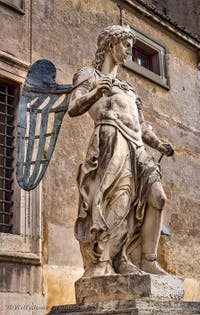
St Michael Archangel During the plague epidemic in Rome in 590, Pope Gregory the Great organized more than 40 processions to end it.
During the last three days, as the procession crossed the Sant’Angelo bridge opposite the castle, the Pope saw the Archangel Michael flying over the mausoleum, holding up his flamboyant sword.
He immediately saw it as the sign of the end of divine wrath and the plague epidemic.
This actually happened from that day on.
Pope Gregory the Great built a chapel at the top of the castle.
Legend or not, that is how the “Domus Theodorici” became the “Castellum Sancti Angeli”, the Castel Sant’Angelo, the name it still bears.
The Ephemeral Angels of Castel Sant'Angelo
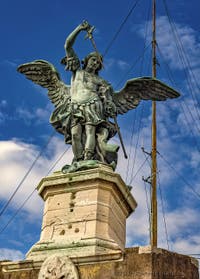
St Michael Archangel The Angel who now sits atop Castel Sant’Angelo is the sixth in a succession of angels who surmounted the castle.
The first Angel crowned the castle only more than six centuries after the famous appearance of Archangel Michael during the plague epidemic of 590.
This sculpture was made of wood and was installed at the top of the building in 1277.
The second Angel was made more durably in marble.
But this is not enough to ensure the longevity hoped for since it was destroyed during an assault on the castle in 1379.
The castle remained without an angel on its summit for nearly sixty years until a new angel, also made of marble, was installed there, but with wings and a bronze sword made by Giacomo da L’Aquila.
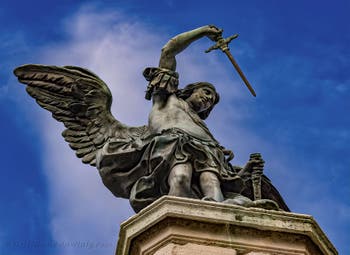
St Michael Archangel But the addition of bronze to the marble of the statue had an unfortunate consequence.
So high and with no other buildings around, what was bound to happen happened: the Angel was struck by lightning on October 24, 1497.
And the Angel was not the only one to be destroyed by lightning because he was on top of a tower which, the second mistake, was also used as a gunpowder deposit.
So the Angel and the tower had been pulverized!
A fourth angel, in bronze, covered with gold, came to replace the thunderstruck Angel.
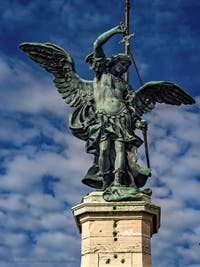
St Michael Archangel But its existence was relatively short, and its destiny sad and not glorious, since it was founded in 1527... to manufacture cannons!
In 1544, Pope Paul III asked the sculptor Raffaello da Montelupo to make a fifth angel, larger in size, in marble and with bronze wings.
His career was much longer than the previous ones since he remained at the top of the castle tower until 1752.
On that date, it was decided to replace it with a new angel, as the bronze wings of the Angel of Montelupo had resisted the elements quite poorly.
During your visit, you will still see the angel number 5, dating from 1544, in the castle courtyard, known as “Cortile dell’Angelo”.
Peter Anton von Verschaffelt, a Belgian sculptor from Flanders, was commissioned by Pope Benedict XIV to make the sixth and last Angel entirely in bronze.
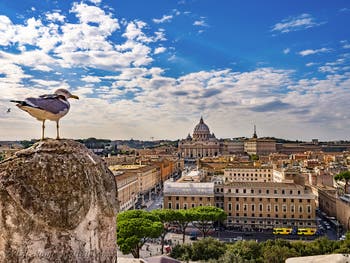
View from Castel Sant' Angelo It is four meters high and is still in use today at the top of the castle, with... a pretty lightning rod just behind it!
An angel who saw all colours.
During the French occupation of Rome in 1798, he was painted blue and white red, wearing a red Phrygian cap and renamed the “Genius of France liberating Rome”.From Mausoleum to Prison, Fortress, Treasury Room and Papal Residence
In the centuries that followed its construction, the mausoleum lost its primary function and became a prison, fortress, safe, and papal residence.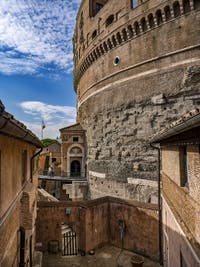
Castel Sant'Angelo It was surrounded by fortifications, raised, and in the 13th century, at the request of Pope Nicholas III, it was linked to the Vatican by a protected and elevated passage that can still be seen today: the “Passetto”.
Around 1400, Pope Boniface IX, helped by the architect Niccolò Lamberti, further unified the castle at the Vatican by using it for the preservation of papal archives and as a safe for the protection of the Vatican treasure.
A treasure room with its massive safe in the centre of the room surrounded by walnut cabinets dating from the 16th century that you can see during your visit to the castle.
It is also understandable that from then on, in the decades following this decision to transfer the Vatican treasure to these places, the castle’s protection was further strengthened by adding angular protection towers.
The beginnings of the Sant’Angelo Fortress
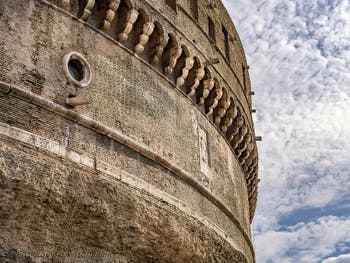
The Castel Sant'Angelo The reasons for this transition from the mausoleum to the fortress are closely linked to the threats that increasingly weighed on Rome.
Thus, in 403, Honorius decided to include the mausoleum in the fortified belt he had built around Rome.
The mausoleum then became a kind of advanced fortress on the Tiber.
As a result of these fortification works, the mausoleum lost its name as the Mausoleum of Hadrian and was renamed the castle.
His new role was quickly confirmed, especially during the attack of the Visigoths of Alaric in 410, followed by that of the Vandals of Genseric in 455.
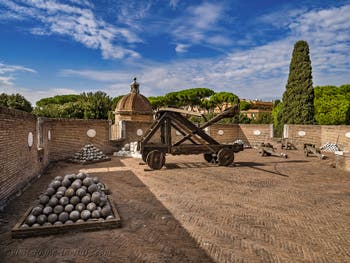
Bastion of Castel Sant'Angelo To defend themselves, the besieged of Castel Sant’Angelo did not hesitate to throw the statues at the top of the mausoleum at the attackers.
And as that was not enough, the marble slabs surrounding the entire building were also detached and used as projectiles against the invaders.
Centuries later, one of these statues, the “Fauno Barberini”, was found in the Tiber at the foot of the castle.
In 1527, Pope Clement VII de’ Medici took refuge in Castel Sant’Angelo with more than a thousand people, including 13 cardinals and 18 bishops.
They remained locked up there for six months to resist the assault by the Lansquenets troops of King Charles V of France.
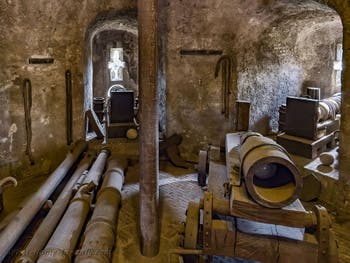
Bastion of Castel Sant'Angelo The Florentine sculptor Benvenuto Cellini was one of the besieged, and in his memoirs, he recounted all his bravery and the importance of his presence during this siege.
Cellini says he killed the Constable of Bourbon with a shot fired from his bomb.
It is not clear whether Benvenuto Cellini actually carried out the fatal bombing, but it is true that the constable died during the castle’s siege.
He did not hesitate to add that while he was fighting like a lion, Raffaello da Montelupo (the sculptor of the castle’s fifth Angel) was terrified and standing curled up in the corner.
The Prisons and Famous Prisoners of Castel Sant’Angelo in Rome
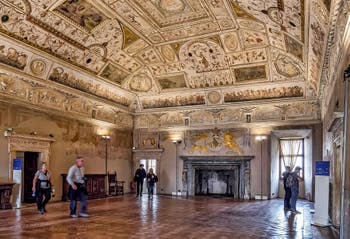
Library room of Castel Sant' Angelo The king of Italy, Theodore (493-526), first used Castel Sant’Angelo as a prison.
The castle then took the name of “Domus Theodorici” and especially “Carceres Theodoroci”, Theodore’s prisons.
During the first half of the 10th century, the castle became the fortress of Senator Theophylact and his descendants, who also used it as a prison.
A use retained by his successors, including the popes and the Italian State, until the end of 1901.
Pope Alexander VI, Rodrigo Borgia, had cells built for important prisoners under the Angel’s Court.
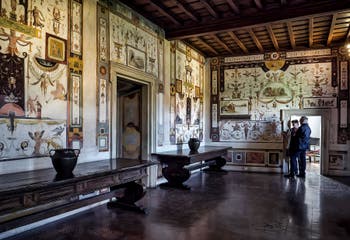
The Cagliostra with Luzio Luzi Frescoes Castel Sant’Angelo thus became the equivalent of the Bastille in Paris or the Tower of London.
But Pope Alexander VI Borgia was not content with keeping only the so-called high-ranking prisoners there. Castel Sant Angelo especially allowed him to eliminate anyone who bothered him.
Cardinal Bartolomeo Flores, archbishop of Cosenza and private secretary of Alexander VI, was imprisoned on October 28 1497.
He was deprived of his titles, stripped of his clothes except for his shirt, and imprisoned in a humid cell.
He was given a crucifix, a prayer book, and a Bible.
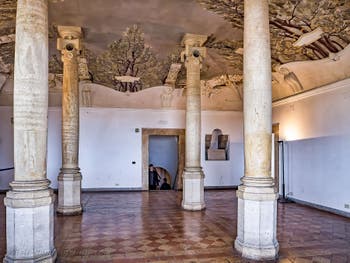
Castel Sant' Angelo: The Columns Room He stayed there until death freed him on July 23 1498. He was buried without any ceremony.
But some said he was poisoned.
Opposing Pope Borgia often meant death.
This was the case of Jerome Savonarola, who was burned for heresy on the order of Alexander VI on the Piazza della Signoria in Florence on May 23, 1498.
In the 16th century, Pope Pius IV had new prisons built on the back of the castle.
Sinister prisons with ceilings so low that prisoners could only stand half-folded in half.
The famous prisoners of Castel Sant’Angelo
The sculptor Benvenuto Cellini at Castel Sant’Angelo
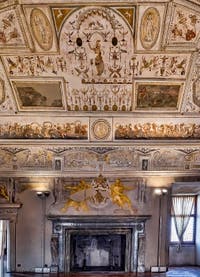
The Library room The Florentine sculptor Benvenuto Cellini, the author of the famous “Perseus” and the one who behaved with bravery and panache during the siege of Charles V in 1527, stayed at the castle again in 1538 and 1539, but this time as a prisoner.
His incarceration followed his conviction for... embezzlement of Vatican funds.
At first, his conditions of detention were pleasant.
He even had a chimney to melt the bronze for the statues he continued to make in prison.
Unfortunately, he had the wrong idea of escaping through his cell window with a rope woven from his sheets.
They caught up with him, and he was imprisoned again for the rest of 1539, this time in one of the castle’s smallest and darkest cells.
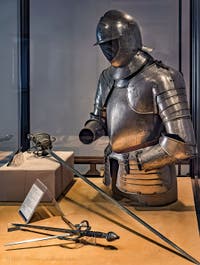
Weapons Room, Corselet He was then pardoned by the Pope.
Beatrice Cenci
Some sixty years after Cellini, poor Beatrice Cenci was also imprisoned here before being executed, beheaded in front of a crowd that included Caravaggio on the Sant’Angelo bridge at the foot of the castle.Giordano Bruno
The monk and philosopher Giordano Bruno was also detained in Sant’Angelo for six years before being sentenced and burned to death on February 17 1600, at the Campo dei Fiori in Rome.Count of Cagliostro
Another famous prisoner who was imprisoned here: was the famous Count of Cagliostro, Giuseppe Balsamo.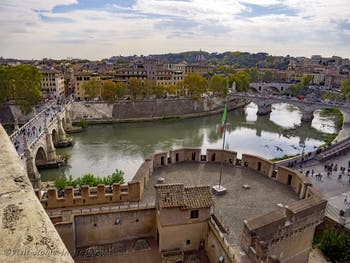
View from Castel Sant' Angelo Suspected of belonging to Freemasonry, he was arrested and imprisoned in 1789 on the order of the Holy Inquisition.
In the 19th century, several prisoners sentenced to death were shot in the castle courtyard.
Their executions were announced by the bell known as the Mercy Bell.
Giacomo Puccini “La Tosca” at Castel Sant'Angelo
The memory of these Roman political prisoners, who, for the most part, were part of the Risorgimento movement, was honoured by Giacomo Puccini in his opera La Tosca.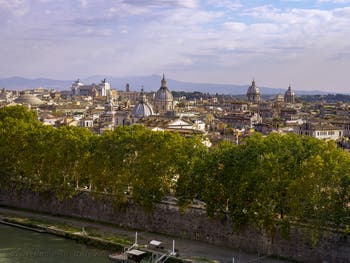
View from Castel Sant' Angelo In “Tosca”, the painter Caravadossi is imprisoned and shot in Castel Sant’Angelo.
His execution led to the sad end of Tosca, his desperate lover who committed suicide by throwing herself into the void from the top of the walls of Castel Sant’Angelo.
Fortunately, from a sinister prison, the castle finally changed its destination: on February 13 1906 it was inaugurated as the Castel Sant’Angelo museum.
A much more civilized use that allows us to visit it and enjoy the exceptional panoramic view it offers over Rome.
Sant'Angelo Art Story | Location | Opening Hours Tickets | Authorisations
Back to Top of Page

